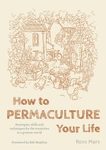Handbook / Manual
Out of Print
By: Patrick Whitefield(Author)
160 pages, b/w photos, b/w illustrations, tables
![How to Make a Forest Garden How to Make a Forest Garden]()
Click to have a closer look
About this book
Related titles
About this book
A forest garden is a food-producing garden, based on the model of a natural woodland or forest. It is made up of fruit and nut trees, fruit bushes, perennial vegetables and herbs. It can be tailored to fit any space, from a tiny urban back yard to a large rural garden. A close copy of a natural ecosystem, it is perhaps the most ecologically friendly way of gardening open to us. It is also a low-maintenance way of gardening. Once established there is none of the digging, sowing, planting out and hoeing of the conventional kitchen garden. The main task is picking the produce!
This highly practical, yet inspiring book gives you everything you need to know in order to create a beautiful and productive forest garden, including:
- Basic principles
- Layout
- How to choose plants
- Details of over one hundred plants, from apples to mushrooms
- The most comprehensive account of perennial and self-seeding vegetables in print
- A step-by-step guide to creating your garden
- Full details of an example garden, and pictures of many more
Forest gardening is an important element of permaculture. This book explains in detail permaculture design for temperate climates and contains much of interest for anybody wanting to introduce sustainable practices into their garden.
Customer Reviews
Handbook / Manual
Out of Print
By: Patrick Whitefield(Author)
160 pages, b/w photos, b/w illustrations, tables
"Patrick Whitefield has succeeded in writing an enjoyable and timely book which will appeal to anyone who yearns to produce food sustainably. Organic gardeners, permaculture designers and growers, ecologists and conservationists will love it. It covers all aspects of designing, planting and maintaining a forest garden; details useful and less obvious plants, from fruit trees to mushrooms; creating home-grown biological resources; controlling pests organically; mulching and no-dig methods. A common thread throughout the book is the balance of sensible, practical suggestions with a wealth of background facts and data. It is both a manual of forest gardening and an important text for permaculture in temperate climates."
– Malcolm New, Permaculture Magazine
"For those with any amount of land who want it to be productive and efficient, here is a book that: Addresses low energy living holistically (from houses to heating to food production); Recommends approaches to growing food all year without overuse of machinery; Chooses crops and approaches that fit with human-powered activity; and Sets you on the right path on nearly any issue of sustainable living. Excellent reading for those who wish to prepare for the day when the world will not be so comfortable."
– James McLaren
"This book is inspirational and practical. It shows how to create an ecosystem of food-producing plants, whether you have a large garden or a few yards of spare ground. The plants are arranged to replicate a woodland or forest environment, with the emphasis on low maintenance and production of food (fruit, nuts, vegetables) throughout the year. Each plant type is described in a very readable manner, with details such as basic growing requirements (soil, light, water), eventual size and yield. Although familiar plants such as rhubarb, raspberries, apples, plums are described, less common but equally viable varieties such as medlar and quince, even kiwis, are treated in equal detail."
– Alan Smith
"Patrick Whitefield's excellent book gives numerous practical details of the steps that many of us can take to realise this alluring vision."
– Robert Hart



































